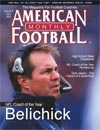AMERICAN FOOTBALL MONTHLY THE #1 RESOURCE FOR FOOTBALL COACHES
Article CategoriesAFM Magazine
|
Special DeliveryMissouri Western puts an emphasis on making special teams specialby: Jerry Partridge © More from this issue At Missouri Western we try to make special teams special. Many coaches have made the statement that special teams are one-third of the game, but actually as far as time spent on the field, they are less than that, but in impact they are more. Special team plays have a major effect on the results of the game. Blocking a punt for a touchdown or returning a kick for “six” more often than not results in victory. Fumbling on a return, having an extra-point or field goal blocked, or getting a punt blocked, will severely hinder your chances to win. Coaches always talk of devoting extra time to special teams. Ten years ago many people were just giving “lip” service to the kicking ....The full article can only be seen by subscribers. Subscribe today!
|
|
|||||||
| HOME |
MAGAZINE |
SUBSCRIBE | ONLINE COLUMNISTS | COACHING VIDEOS |
Copyright 2025, AmericanFootballMonthly.com
All Rights Reserved





